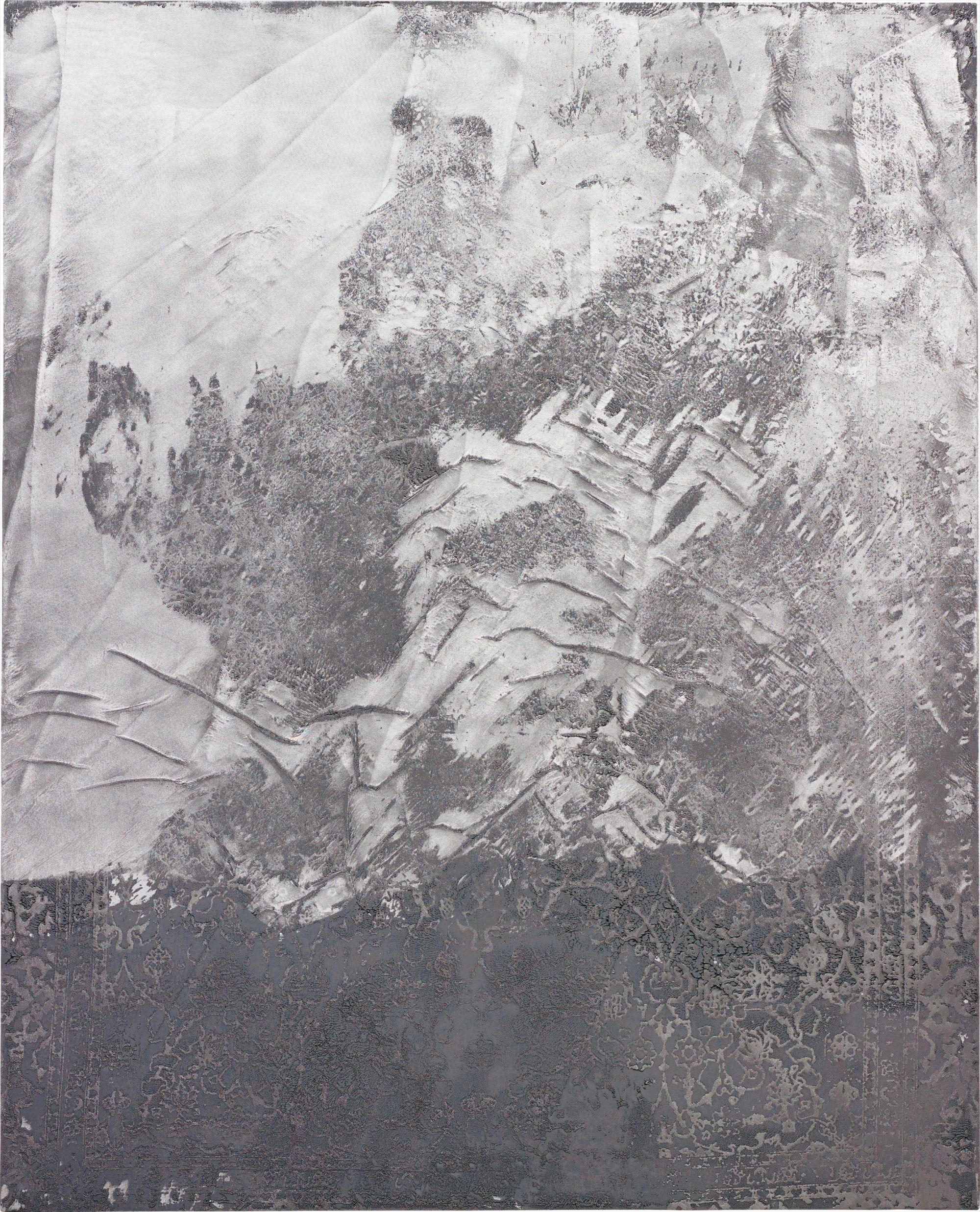

12
Rudolf Stingel
Untitled
Full-Cataloguing
“In 1989 I rented the former showroom of 'Magic Carpet' on Houston Street as a studio. There was wall-to-wall carpet covering the entire floor of the loft space......It took me a while but at some point I realized that taking an entire space by laying carpet was more powerful than the paintings I was doing at that time.” Rudolf Stingel, 2013
Rudolf Stingel’s exploration of decoration as a mode of art is one of the most defining elements of his distinguished career. For Stingel, beneath every expressive motif of the Persian carpet lies a varied story of power, wealth, and beauty—and, when combined with his own technique of silkscreen, each canvas takes on a hybrid quality, at once a meditation on the historical semiotics of prestige and a breathtaking transformation of one our most perennial and beloved design patterns. As opposed to most of Stingel’s carpet paintings, the present lot represents a singular departure from order and measured placement, instead choosing to embody the chaos and exceptional beauty of imperfection. Untitled, 2013 is more than just another one of Stingel’s seminal works: it is a painting without parallel.
First bursting onto the New York scene in the late 1980s, Stingel gained both notoriety and widespread praise for his 1989 manual titled “Instructions”, which led the reader through his creative process, seemingly blurring the line between creator and observer. Many of his later series explored this relationship more deeply, calling upon the viewer’s interaction and tactile participation.
The Carpet Paintings have undergone a similar internal evolution. While they have constituted one of Stingel’s most reliable series of the past twenty-five years, that is not to say that they appear uniform in appearance. Carving out a silkscreen pattern from the surface of Persian Carpets, Stingel first employed only a single shade of white, silver or black for his paintings. In more recent years however, Stingel’s work has shifted to include dichromatic schemes as well, which we see at work in spectacular form in the present lot.
The bottom half of Untitled, 2013 falls stylistically in line with much of Stingel’s earlier carpet paintings: we find the perfect pattern of a Persian rug, floral designs sprouting from a central axis, then blossoming in perfect parallel schemes as they branch out towards the edge of the carpet. It seems as though Stingel has gone to even greater lengths in this particular work to lay his silkscreen facsimile completely flush with the two sides of his canvas (perhaps even choosing a canvas that fit the size of the carpet, as opposed to his usual technique of multiple silkscreens upon the same canvas).
But the similarity to his earlier work stops there. Above, a vast storm of pigment, shadow, and abstraction dominates the space, mercilessly scattering any vague sense of painterly decorum or designer etiquette. Huge swaths of silver lay over an undercurrent of pulsating charcoal, which burns through the neutral layers that lie atop of it. Stingel has created a geographic spectacle for us: the vast sands of the desert in silver are in constant combat with a firestorm of darker greys, both locked in constant struggle across the landscape of the canvas.
This gorgeous spin on Stingel’s more controlled canvases of the past serves only to intensify the message within: that ageless motif of wealth and power, the Persian carpet, enjoyed by emperors and merchants alike, is now dissolving upon itself, disseminated throughout the world as a symbol of beauty as opposed to prestige. Stingel manages to illustrate the changing arc of history through his pictorial genius.
For artistic feats such as these, Stingel has proven himself without equal in the artistic community. It is one reason that he has defied stylistic categorization: “Stingel is hard to pigeon-hole: the industrial procedures and mechanically produced materials he uses relate to the Minimalist tradition, while the colour, size and lavishness of his works deny this connection. Indeed in 1993, when he exhibited a huge plush orange carpet glued to the wall at the Venice Biennale, many cited its connections to the Colour Field painting of Mark Rothko.”(A. Coulson, “Rudolf Stingel”, Frieze Magazine, Issue 86 (October 2004). Aside from his contemporary Christopher Wool, who also employs symbolic decorative motifs to a great extent, perhaps Rothko is the best comparison for Stingel’s overall project: one who ventures to highlight artistic power through its visual portraiture. Untitled, 2013, represents a later and more radically commanding period of Stingel’s work, one where his subversive influence is as great as his visceral punch. Through paintings such as the present lot, Rudolf Stingel has done us a great service: to continually question the nature of what it means to be a painter in today’s world.
Rudolf Stingel
Italian | 1956Rudolf Stingel came to prominence in the late 1980s for his insistence on the conceptual act of painting in a context in which it had been famously declared dead. Despite the prevailing minimalist and conceptual narrative of the time, the Italian-born artist sought to confront the fundamental aspirations and failures of Modernist painting through the very medium of painting itself. While his works do not always conform to the traditional definitions of painting, their attention to surface, space, color and image provide new and expanded ways of thinking about the process and "idea" of painting. Central to his multifarious and prolific oeuvre is an examination of the passage of time and the probing of the fundamental questions of authenticity, meaning, hierarchy, authorship and context by dislocating painting both internally and in time and space. Stingel is best known for his wall-to-wall installations, constructed of fabric or malleable Celotex sheets, as well as his seemingly more traditional oil-on-canvas paintings.